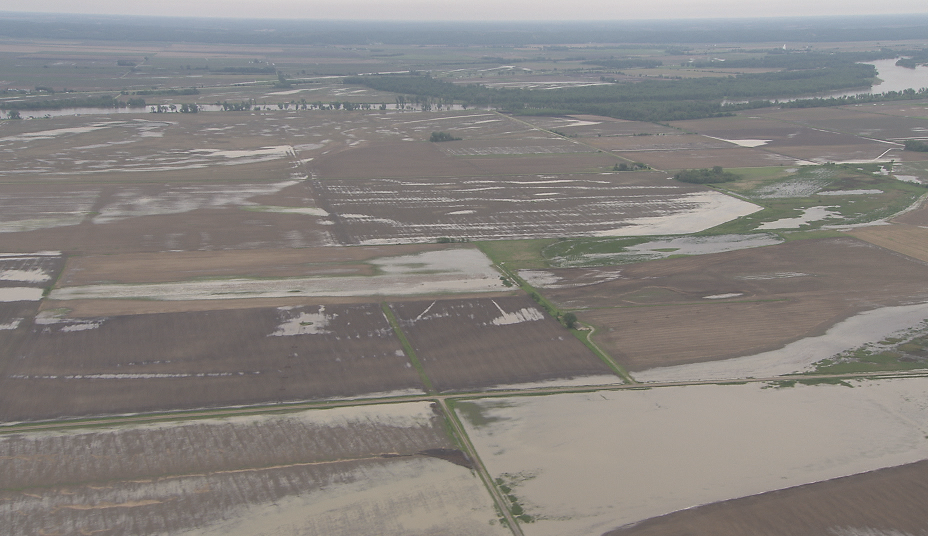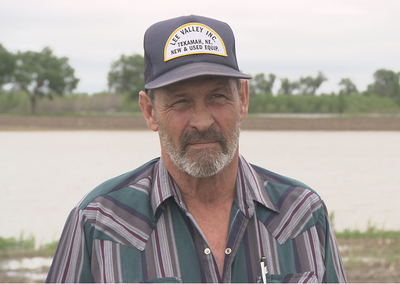Soaked Fields a Challenge for Nebraska Farmers Trying to Plant
By Jack Williams, Managing Editor and Reporter Nebraska Public Media News
June 6, 2019, 6:45 a.m. ·

Listen To This Story
It’s been almost three months since massive flooding washed over parts of Nebraska, Iowa and Missouri, but for many farmers, recovery has been slow. Continued wet weather and lingering high water has delayed planting for many growers who can’t afford to miss out on a good crop this season. Some farmers are stuck just waiting for soggy fields to dry out.
For Scott Olson, who farms around 3,000 acres of corn and soybeans near Tekamah, in northeast Nebraska, getting a good look at his land these days takes more than just a pick-up truck. Olson is a farmer, but he’s also a pilot and uses his airplane, a small Cessna 172, to check on areas he can’t access because of high water from the nearby Missouri River, which snakes along the border of his property. When we talked to him about a month ago, things weren’t good and not much has changed since then.
“The water’s high enough now, it’s covering over the roads,” Olson said. “The other entrance into this field to the north is also underwater, so at this point in time right now I can’t even get into my farm ground down here.”
Olson has been able to plant more than a thousand acres of higher ground, but the land by the river, about 500 acres, still looks like a big, muddy lake.
“If you walk across mud, just think about running a tractor and planter across it. You can’t touch it. There’s nothing you can do with it,” he said.

Farmer Scott Olson on his farm near Tekamah, Nebraska. (Photo by Chris Flanery, NET)
For him, there’s not much time to get corn and soybean seed into the ground. Like many other farmers across the Midwest, he’s lagging behind his normal planting schedule.
“Corn has to have a certain amount of daylight hours and heat units to grow and produce to have a decent crop,” Olson said. “The further we get into this month of June, the less crop it will produce. Within a two week period, this ground needs to dry out so we can get a crop in, otherwise, our crop will be greatly depleted on it.”
Near Lincoln, Dave Nielsen has been one of the fortunate ones. He farms around 2,400 acres of corn and soybeans in the rolling hills and has been able to plant all of his crops despite the wet weather.
“There was a small window to plant corn and beans around here and we pushed hard and got it done,” Nielsen said. “That’s been a benefit for us. We put in some extra-long hours. Soil temps weren’t quite warm enough but we went ahead and we lucked out.”
After a wet fall last year, lots of snow and frost over the winter, and now a soggy spring, Nielsen says his corn and soybeans could use some drier weather.

Farmer Dave Nielsen near Lincoln, Nebraska. (Photo by Chris Flanery, NET)
“They like moisture, but they don’t want to sit in wet weather all the time. You want the water to percolate down through and you want the crops to get a good root structure,” he said. “You want corn to kind of root down so when we do get a dry time, it’s got its root base there or if you get bad weather, you know, winds and stuff, you want a good root base on your corn so it doesn’t blow over.”
Nielsen’s family has been farming this land for over 100 years and they’ve seen many ups and downs. For his operation, the weather isn’t as disruptive as tariffs and a trade stand-off with China. He says it could take years to reconnect with buyers.
“There’s going to be long-term effects. This isn’t, we drop the tariffs and the next day, we’re shipping as many beans as we did a year ago. That’s not going to happen,” he said.
In a field full of old corn stalks near Plattsmouth, Nebraska, John McNamara bends over and digs into plant debris and mud. He’s an agronomist and helps growers decide when to plant. This year hasn’t been easy.
“You’ve got tariffs, you’ve got low commodity prices, you’ve got weather delays, you’ve got input prices that are high and a whole host of other things that weigh on the strategies that go into a cropping season,” McNamara said.
He says if farmers can’t get seed into the ground soon, crop yields will likely fall off sharply. There is crop insurance, but if corn and soybeans aren’t in before mid-June, the payouts fall drastically.

Agronomist John McNamara in Plattsmouth, Nebraska. (Photo by Chris Flanery, NET)
“We do reach a point in June where your expectations for your average yield have got to go down because you don’t have enough calendar year to get the crop mature,” he said. “Soybeans are different than corn in that you can still plant soybeans out into the 10th or 15th of June with very little yield penalty, but everything else has to go right.”
Back down by the Missouri River at Scott Olson’s place near Tekamah, a little good news and good weather would go a long way. Corn and soybean prices have rebounded a bit in the last couple of weeks, but it’s still a tough way to make a living.
“Just like any other business, I guess you have good years and you have some bad years, but it’s something that we’ve always done, it’s always been a way of life. I don’t want to give it up,” Olson said.
He says farming is all about patience and perseverance, and he says he and a lot of other Nebraska growers have an abundance of both.